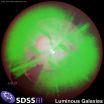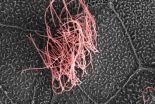(Press-News.org) Interferon-stimulated gene 15 (ISG15), a ubiquitin like protein, is highly elevated in a variety of cancers including breast cancer. How the elevated ISG15 pathway contributes to tumorigenic phenotypes remains unclear and is the subject of a study published in the January 2012 issue of Experimental Biology and Medicine. Dr. Shyamal Desai and her co-investigators from the Louisiana State University School of Medicine in New Orleans, the University of Pennsylvania School of Medicine in Philadelphia, and the Robert Wood Johnson School of Medicine in New Jersey report that gene knock-down studies demonstrate that elevated ISG15 pathway results in disruption of the cytoskeletal architecture of breast cancer cells. ISG15 also inhibits degradation of cellular proteins involved in cell motility, invasion, and metastasis, promoting breast cancer cell migration.
Dr. Desai said "Using ISG15 and UbcH8 gene knocked-down approach, our recent published and unpublished results explicitly demonstrated that the ISG15 pathway inhibits the ubiquitin-mediated proteasome-dependent protein degradation in breast cancer cells. We were the first to recognize this antagonizing effect of ISG15 in cancer cells"; however, others are increasingly coming to the same conclusion in their observations that ISG15 conjugation stabilizes cellular proteins.
Dr. Arthur Haas said "Given the crucial role of the ubiquitin/26S proteasome pathway in normal cell homeostasis, one expects that ISG15-induced downregulation of the ubiquitin pathway must contribute to breast tumor cell viability. Concurrently, in this manuscript we demonstrate that ISG15 promotes breast cancer cell migration by inhibiting ubiquitin-mediated degradation of cellular proteins associated with cell motility, invasion and metastasis".
The authors report that the elevated ISG15 pathway results in disruption of the cytoskeletal architecture effecting actin polymerization and formation of focal adhesions in breast cancer cells. Targeted knockdown of both ISG15 and UbcH8 resulted in reconstitution of the cytoskeletal architecture. Dr. Desai said "Disruption of cellular architecture is a hallmark of cancer. The ISG15 pathway is also elevated in a variety of tumors. Our results therefore reveal that the ISG15 pathway which is aberrantly elevated in tumors could disrupt cell architecture and contribute to breast cancer cell motility". "Because the cellular architecture is conserved and the ISG15 pathway is constitutively activated in tumor cells of different lineages, our observations in breast cancer must hold true for many other tumors".
If ISG15 confers motility to tumor cells in vivo, as suggested in this manuscript, then Dr. Desai concludes that "strategies to decrease ISGylation could provide a therapeutic advantage for patients diagnosed with metastatic tumors overexpressing the ISG15 pathway".
Dr. Steven R. Goodman, Editor-in-Chief of Experimental Biology and Medicine said that "these intriguing studies by Desai and colleagues suggests that modulation of the ISG15 pathway may provide future therapeutic targets for breast cancer and other metastatic tumors".
###Experimental Biology and Medicine is the journal of the Society of Experimental Biology and Medicine. To learn about the benefits of society membership visit http://www.sebm.org. If you are interested in publishing in the journal please visit http://www.ebmonline.org.
ISG15: A novel therapeutic target to slow breast cancer cell motility
2012-01-13
ELSE PRESS RELEASES FROM THIS DATE:
Calculating what's in the universe from the biggest color 3-D map
2012-01-13
Since 2000, the three Sloan Digital Sky Surveys (SDSS I, II, III) have surveyed well over a quarter of the night sky and produced the biggest color map of the universe in three dimensions ever. Now scientists at the U.S. Department of Energy's Lawrence Berkeley National Laboratory (Berkeley Lab) and their SDSS colleagues, working with DOE's National Energy Research Scientific Computing Center (NERSC) based at Berkeley Lab, have used this visual information for the most accurate calculation yet of how matter clumps together – from a time when the universe was only half its ...
Stenting for stroke prevention becoming safer in high-risk patients
2012-01-13
MADISON –Placing a stent in a key artery in the neck is safer than ever in patients ineligible for the standard surgical treatment of carotid artery disease, according to a new study published online today in the Journal of Vascular Surgery.
A team of researchers led by Dr. Jon Matsumura, head of the vascular surgery division at University of Wisconsin School of Medicine and Public Health, found the clinical trial PROTECT (Carotid Artery Stenting with Distal Embolic Protection with Improved System) had the lowest rate of complications ever in patients considered high ...
Evolution is written all over your face
2012-01-13
Why are the faces of primates so dramatically different from one another?
UCLA biologists working as "evolutionary detectives" studied the faces of 129 adult male primates from Central and South America, and they offer some answers in research published today, Jan. 11, in the early online edition of the journal Proceedings of the Royal Society B. The faces they studied evolved over at least 24 million years, they report.
"If you look at New World primates, you're immediately struck by the rich diversity of faces," said Michael Alfaro, a UCLA associate professor ...
UMass Amherst chemical engineers boost petrochemical output from biomass by 40 percent
2012-01-13
AMHERST, Mass. – Chemical engineers at the University of Massachusetts Amherst, using a catalytic fast pyrolysis process that transforms renewable non-food biomass into petrochemicals, have developed a new catalyst that boosts the yield for five key "building blocks of the chemical industry" by 40 percent compared to previous methods. This sustainable production process, which holds the promise of being competitive and compatible with the current petroleum refinery infrastructure, has been tested and proven in a laboratory reactor, using wood as the feedstock, the research ...
Hubble breaks new ground with discovery of distant exploding star
2012-01-13
NASA's Hubble Space Telescope has looked deep into the distant universe and detected the feeble glow of a star that exploded more than 9 billion years ago. The sighting is the first finding of an ambitious survey that will help astronomers place better constraints on the nature of dark energy, the mysterious repulsive force that is causing the universe to fly apart ever faster.
"For decades, astronomers have harnessed the power of Hubble to unravel the mysteries of the universe," said John Grunsfeld, associate administrator for NASA's Science Mission Directorate in Washington. ...
LSU professor discovers world's tiniest vertebrate
2012-01-13
BATON ROUGE – LSU's Chris Austin recently discovered two new species of frogs in New Guinea, one of which is now the world's tiniest known vertebrate, averaging only 7.7 millimeters in size – less than one-third of an inch. It ousts Paedocypris progenetica, an Indonesian fish averaging more than 8 millimeters, from the record. Austin, leading a team of scientists from the United States including LSU graduate student Eric Rittmeyer, made the discovery during a three-month long expedition to the island of New Guinea, the world's largest and tallest tropical island.
"It ...
New species of tiny frog is world's smallest vertebrate
2012-01-13
Researchers have found two new frog species in New Guinea, one of which is the new smallest known vertebrate on Earth. The results are reported in the Jan. 11 issue of the online journal PLoS ONE, and the team of researchers was led by Christopher Austin of Louisiana State University.
The new smallest vertebrate species is called Paedophryne amauensis, named after Amau Village in Papua New Guinea, where it was found. The adult body size for these frogs ranges from just 7.0 to 8.0 millimeters.
According to Dr. Austin, the discovery "is of considerable interest to biologists ...
Selectively stopping glutathione sensitizes brain tumors to chemotherapy
2012-01-13
Brain cancer cells are particularly resistant to chemotherapy — toxins enter the cells, but before the toxins can kill, cancer cells quickly pump them back outside. In fact, brain cancer cells are even better than healthy cells at cleaning themselves. This means that when hit with chemotherapy, healthy cells tend to die before brain cancer cells. Especially in the brain, killing healthy cells is bad.
Researchers at the University of Colorado Cancer Center have discovered a way to turn off the pumps — only in brain cancer cells and not in their healthy neighbors. Promising ...
Diet counts: Iron intake in teen years can impact brain in later life
2012-01-13
Iron is a popular topic in health news. Doctors prescribe it for medical reasons, and it's available over the counter as a dietary supplement. And while it's known that too little iron can result in cognitive problems, it's also known that too much promotes neurodegenerative diseases.
Now, researchers at UCLA have found that in addition to causing cognitive problems, a lack of iron early in life can affect the brain's physical structure as well.
UCLA neurology professor Paul Thompson and his colleagues measured levels of transferrin, a protein that transports iron ...
Scientists identify gene crucial to normal development of lungs and brain
2012-01-13
La Jolla ---- Scientists at the Salk Institute for Biological Studies have identified a gene that tells cells to develop multiple cilia, tiny hair-like structures that move fluids through the lungs and brain. The finding may help scientists generate new therapies that use stem cells to replace damaged tissues in the lung and other organs.
"Cells with multiple cilia play a number of important roles, including moving fluids through the respiratory tract, brain and spinal cord," says Christopher R. Kintner, a professor in Salk's Molecular Neurobiology Laboratory, who led ...



